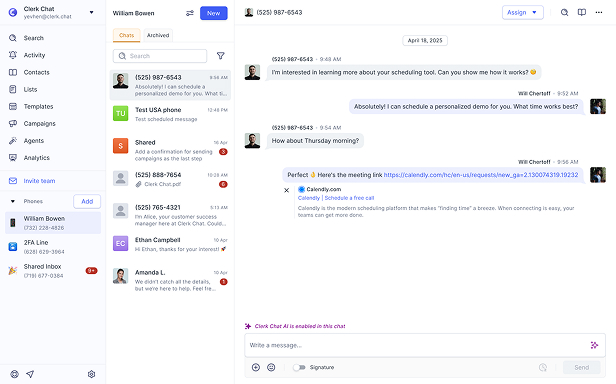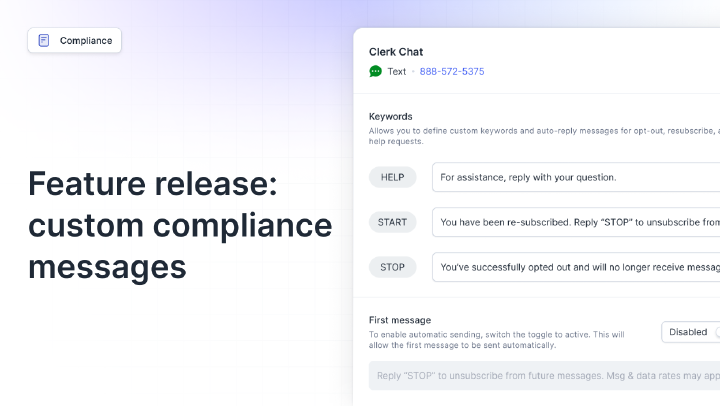AI Agent
[eɪ aɪ ˈeɪdʒənt]An AI Agent is an autonomous software entity that performs tasks independently by perceiving inputs, reasoning, and acting to meet objectives.
In customer communication, it handles interactions like queries and follow-ups via text or voice. This technology combines NLP and ML for natural, efficient engagements.
Why AI Agent Matters
AI Agents redefine customer service by enabling proactive, personalized interactions that scale without added staff, directly lifting satisfaction and loyalty. They resolve issues faster, often in seconds, minimizing wait times and frustration, which translates to lower churn rates. In competitive landscapes, this autonomy frees human teams for high-value tasks, optimizing resources and driving productivity gains.
They also unlock data insights from conversations, revealing trends that inform strategies and product refinements. For businesses, this means higher conversion rates in sales funnels and stronger relationships through consistent, context-aware support. Adoption correlates with revenue boosts, as seen in sectors where engagement metrics improve by 25-40%, positioning AI Agents as key for sustained growth.
How AI Agent Works
AI Agents follow a perceive-plan-act cycle, adapting to dynamic environments for task completion.
Perception: The agent gathers data from inputs like user messages or databases, using sensors or APIs to understand context.
Reasoning and Planning: It analyzes information with ML models to identify intents, predict outcomes, and formulate steps, often employing algorithms for decision-making.
Action Execution: The agent performs tasks, such as sending replies, updating records, or integrating with tools like CRMs for actions like scheduling.
Feedback Loop: It evaluates results against goals, learning from successes or failures to refine future behaviors via reinforcement learning.
Collaboration: In multi-agent setups, it coordinates with others, dividing complex workflows for efficiency.
Adaptation: Over time, exposure to new data enhances capabilities, improving accuracy in handling variations.
In customer engagement, an AI Agent might receive a text query, interpret needs, retrieve account details, generate a response, and log the interaction - all autonomously.
Best Practices with AI Agent
Define Precise Objectives: Outline specific goals and scenarios to guide development, ensuring alignment with business priorities for focused functionality.
Secure Diverse Training Data: Collect broad, representative samples to train models, reducing biases and enabling robust handling of real-world variations.
Establish Oversight Mechanisms: Implement monitoring and human intervention points for critical decisions, balancing autonomy with accountability.
Integrate Seamlessly with Systems: Connect agents to existing tools via APIs for smooth data flow and enhanced capabilities in workflows.
Prioritize Ethical Design: Audit for fairness, transparency, and privacy, incorporating guidelines to mitigate risks in sensitive interactions.
Measure and Iterate Continuously: Track key metrics like task success and user feedback, using insights to update models regularly.
Scale Gradually: Start with pilot programs in limited areas, expanding based on performance to manage implementation risks.
Real world examples
- Education
Institutions automate student advising with AI Agents, reducing query times by 50% and boosting enrollment.
Read more - Nonprofits
Groups use AI Agents for donor engagement, increasing response rates by 30%.
Read more
Common misconceptions
They augment human efforts by managing routine tasks, allowing staff to focus on complex, empathetic interactions.
They rely on extensive datasets and continuous learning to interpret contexts and improve performance accurately.
Unlike scripted chatbots, AI Agents act autonomously, reasoning and executing multi-step processes.
Biases in training data can lead to unfair outcomes, requiring careful auditing and diverse datasets.
They may falter in ambiguous situations, necessitating human oversight for reliability.
Related terms
In this article:
Ready to use your business number for text messaging?
Thousands of businesses are already experiencing the power of conversational messaging through SMS. Join us. Free trial and paid tiers available.
Get StartedFAQ
Have questions? We've got answers.
Find what you need quickly and clearly with our most frequently asked questions.
An AI Agent is an autonomous program that perceives environments, makes decisions, and executes actions to achieve goals. In customer communication, it manages tasks like lead qualification and follow-ups via text or voice. Built on NLP and ML, it processes queries in real-time, offering 24/7 support and personalization, which can lift satisfaction scores by 20-30% in various sectors.
Assess needs by reviewing interaction data to pinpoint automation opportunities. Choose platforms with robust APIs, train on domain-specific examples, and integrate into existing systems. Test iteratively with real scenarios, then launch with monitoring. Solutions like Clerk Chat provide ready AI Agents for texting, syncing contacts and qualifying leads swiftly.
Subscriptions range from $50/month for basics to thousands for enterprise features, plus per-action costs at $0.001-0.01. Setup demands data preparation (days to weeks) and developer input for customization. Maintenance involves model updates. Benefits include 40% workload reduction, yielding quick ROI through efficiency gains.
Traditional tools follow fixed rules, while AI Agents adapt via learning, handling dynamic contexts and multi-step tasks. They predict needs proactively, unlike reactive scripts, cutting resolution times by half. Though more resource-intensive initially, AI Agents scale better for complex engagements over simple bots.
Follow GDPR for data consent and TCPA for messaging permissions. Secure interactions with encryption, audit for biases, and enable opt-outs. In the US, 10DLC registration prevents spam flags. Non-compliance risks fines exceeding $500 per incident; built-in features in platforms aid adherence.
Define clear objectives and personas. Use diverse training data to cover variations. Incorporate feedback loops for continuous improvement. Set escalation protocols for uncertainties. Analyze metrics like resolution rate and sentiment to tweak responses, achieving up to 95% accuracy in targeted domains.




